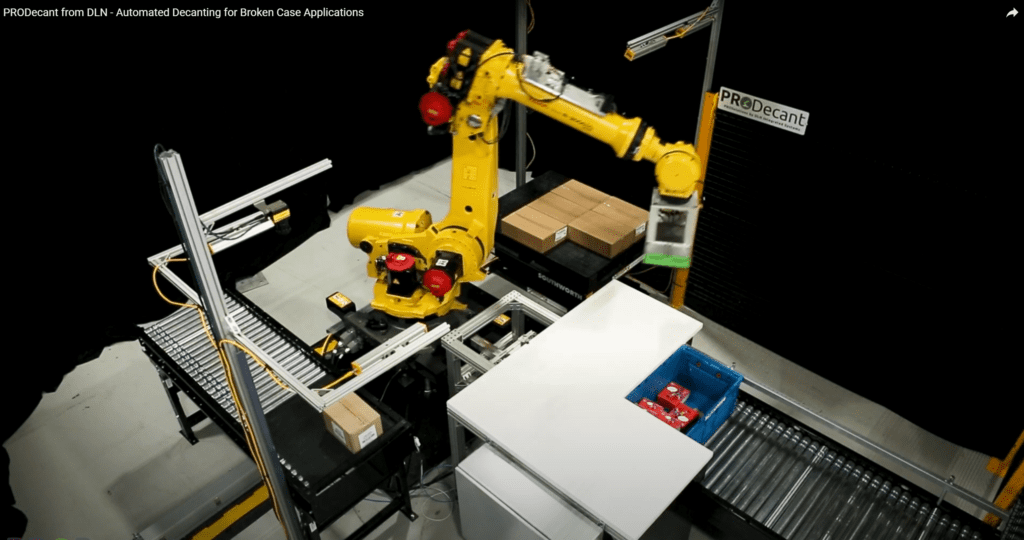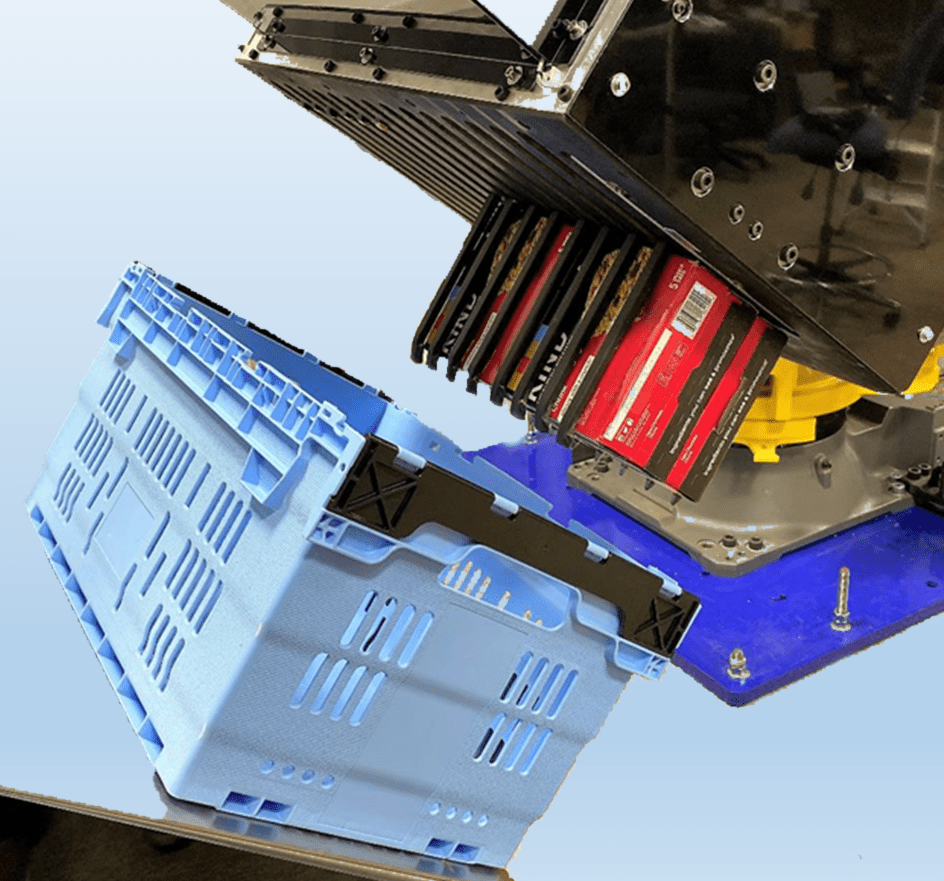Retail, especially in the grocery sector is in need of cost-effective automation to meet the demands of unprecedented growth. Order picking tasks are finding solutions. Decanting operations are virtually ignored as the second-highest and most dangerous labor content.
As per LogisticsIQ, warehouse automation markets are expected to reach ~$30B by 2026, at a CAGR of almost 14% between 2020 and 2026. The growth of this market can be attributed to the eCommerce industry, multi-channel distribution channels, the emergence of autonomous mobile robots, and eGrocery.
“The Grocery industry is one of the most challenging and attractive industries from a logistics perspective. Grocery distribution center operations are among the most labor intensive of any industry. Higher automation driven by online grocery, micro-fulfillment centers and COVID-19 is going to be the largest opportunity in the next 2-3 years. Led by ASRS, Delivery Robots and Micro-Fulfillment, the market is expecting sales of~$5B by 2026 with ~18% growth rate.”
The highest labor content in grocery distribution is order picking and fueling the vast majority of the automation growth.
This year 290 companies and startups are actively producing solutions for the goods-to-man market targeting order picking. Application of goods-to-man can cost in the millions of dollars.
The solutions provided vary in technology making manual fulfillment functions more efficient. About half of the labor cost is eliminated in the order picking task after seven-figure material handling investments. Most of the remaining operations are reliant on manual labor.
Now, established providers and dozens of start-ups backed with hundreds of millions in investor cash are beginning to offer robotic piece-picking to automate much of the remaining picking task. Order picking labor is expected to be further reduced from 27% to about 6% of the total fulfillment labor cost. The addition of piece picking robotics automates about 90% of the order picking labor.
Most studies agree prior to automation, the labor content for order picking operations in grocery warehouses was 55% of the total labor cost followed by 25% for decant operations.
Billions are going towards automating the picking operations and virtually no investment for automating decant.
So what is decant? Most of the technologies described above for automating grocery distribution rely on uniform storage and handling container (i.e. storage tote). Decant is the process of removing the grocery goods from their original shipping containers and placing units (i.e. contents) into totes for storage and movement to pickers and robots.


With the rush to automate almost every aspect of retail fulfillment, why is decant ignored?
It is the timing. Much of the goods to man automation were progressions of conveyor, material handling improvements, and technology migrations over the years. The more recent introduction of robotics and AMR solutions provided major advancements in lowering cost and installation time. Goods to man market expand as robotics offer modular and scalable solutions bringing justifications from three to four years to under two years.
Market expansion of goods to man solutions set the table for robotic piece picking. Robotic piece picking cost is coming down and becomes justifiable when combined with low-cost goods to man or goods to robot solutions. Now with the automation of the highest labor cost, automating decant is coming into focus.
Only recently has decant been mentioned as an automation target.
On November 2, 2020, Forbes reports Ocado, an innovative leader in online-only grocery retail robotics is targeting automating decant operations.
“There are two human-driven processes in warehouses — decanting and picking — which Ocado says cost US$9 million per warehouse, per year.”
https://fortune.com/2020/11/02/british-online-grocer-ocado-known-for-its-automated-warehouses-acquires-two-u-s-robotics-companies/
With the automation of order picking, decant is becoming the highest and most dangerous labor content for grocery fulfillment. The danger to workers and associates comes from lifting heavy boxes and cutting with razor sharp blades opening shipping boxes.
In 2017 Robotica Inc demonstrated at Promat piece picking of soft goods (e.g. socks) long before others. In 2018 Robotica made a pivot leaving behind piece picking and began development into pack out and decant automation. Areas where few solutions existed.
Efforts where accelerated early in 2020 due to pressures brought on by Covid19. Alpha prototype was constructed known as DePack™ and demonstrated with very high success. For the first time, a shipping box goes in and units (contents of the box) carefully packed into tote sub-compartments comes out.
Robotica Inc, filed three new major patents for decant technology and successfully demonstrated complete decant automation in 2020. Continued testing and development is producing production ready versions of the robotic decant system capable of paybacks in under a year.
Much of the technology for automated decant was already in Robotica’s IP portfolio. Robotica Inc.’s long history of developing box opening technologies resulting in four patents domestically and four internationally. Automated Box Opening Technology known as ABOT® is a key component in automating decant. ABOT generation II is now complete with state of the art robotics, metrology and AI capabilities. The computational and sensing power in the ABOT M1 is unparalleled in industry serving as the intelligent platform for automated decant processes.
Continued testing and development of the DePack produce beta improvements and new capabilities. Now, standard delivery units of ABOT M1 and DePack are in production. 2020 development produced production systems for 2021 with increased handling abilities, increased rates, smaller footprints and cost reductions. Multiple installs are slated for 2021.
To date, no evidence can be found that anyone other than Robotica Inc has cracked the code on developing a complete and viable automated solution for decant.
Other decant solutions under development fall short using piece picking or cut and dump methods.
Piece picking offers careful handling and the ability to produce volumetrically efficient stacks in the tote and sub-compartments. The issue is rate and flexibility. Piece picking in general is limited to a restricted subset of units. Varying AI capabilities place limits on the picking systems ability to recognize units as packed in a shipping box. Tooling requirements also limit what can be picked. Consider the vast range of constantly changing product packaging. The range may extend from one gallon jugs of milk to vertically oriented thin foil packages of dip mix to blister packs of cosmetics.


Above all, piece picking suffers from low rates. Piece picking robot cell decanting would do well at about 600 units per hour. Larger heavier items would be slower with various tooling actuation times. Piece picking claims of higher rates would not apply as picks and placements must be calculated and controlled.
A single piece picking cell may average 500 units per hour of limited package configurations.
Robotica Inc DePack can handle up to 10,000 units per hour with far fewer limitations on unit packaging.


Cut and dump methods offer a very cost-effective approach. The downside is items are allowed to free fall into the tote with the potential of damage to products and packaging. This can be an issue with glass items or heavy liquids with fragile seals. Scattered arrangements from units free falling typically do not yield good volumetric efficiencies and likely prevent loading multiple shipping cases into the tote. Free falling does not work well for fitting units into subdivided totes.
Piece picking and dumping decant technologies rely on box opening of randomly sized boxes.
Robotica Inc owns the most successful and proven technology for automating box opening. Viable alternatives are yet to be seen.


In automated decant operations, the function of the box opening is crucial. Automated box opening of the past fed picking or decanting operations maned by workers. Issues with the automation opening boxes partially are addressed by the downstream workers manually
Automated decant cannot rely on workers to correct box opening issues.
With years of experience designing and producing multiple commercialized automated opening technologies, Robotica is now producing generation II ABOT for automated decant.
ABOT uses data elements for optimizing opening boxes for the best success without damage to the contents. Generation one systems required manual input for various packaging and were maintained in a database.
Modern eCommerce warehouses operate with thousands of SKUs with packaging and shipping cartons that constantly change. Maintaining a database of this magnitude would be labor-intensive, time-consuming, and not practical. ABOT Generation II is autonomous learning the best approach to cutting and opening the various carton sizes and configurations. This enhances both higher box opening success and protection for goods and items inside.
Robotica Inc Decant Solution
ABOT and DePack decant technology is offered in two modular standard production models for fast delivery and installs. ABOT/DePack systems are suitable for micro-fulfillment and large DCs.
A single DePack-Micro processes up to 400 shipping cases per hour and a single DePack-DC handles up to 800 cases per hour. Higher rates available with multiple cells. Options include automated receiving, de-palletizing, dimensioning, weighing, and scanning.
Robotica decant automation works well with robotic material movement or existing conveyor. DePack simplifies material movement for decant. Both replenishment supply (i.e. donor case) and order inventory (i.e. totes) are handled, buffered and managed.


Robotica DePack systems will interface directly with various AMR or goods to man robotics without need of special programming or interface equipment. DePack is adept at receiving and delivering inventory totes to and from static shelf positions. DePack can access totes randomly for buffering, SKU matching and/or compartment matching.
Preprogramming DePack for specific SKUs or items shapes and case sizes is not required. First time cases and contents are automatically handled based on rules constantly fined tuned by DePack AI
For volumetric efficiency, multiple caseloads of unit items can be placed to a tote or sub-compartment. Sub compartment sizes are automatically matched with unit batch size. Item consolidation abilities aid in replenishing partially filled totes. DePack can create empty space or voids with partially filled with randomly scattered items in the tote. DePack would then fill the void created with replenishment items.


DePack handles an extremely wide range of unit shapes, sizes and packaging. Cans, bottles, free form shapes and blister packs all handled automatically. Orientation of unit items is variable based on best fit or overridden (top of unit up) for items prone to leaking. Glass items and fragile unit items are loaded gently. Empty shipping cases and tops are automatically handled to recycling. Keep in mind most everything ordered on-line delivered to your door or automobile came from a shipping box.
Decant, the second-highest labor cost has no solution. Until now.






